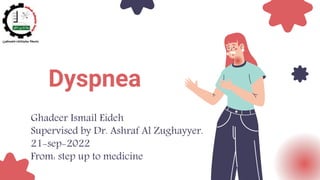
Dyspnea Guide: Causes, Diagnosis and Treatment
- 1. Dyspnea Ghadeer Ismail Eideh Supervised by Dr. Ashraf Al Zughayyer. 21-sep-2022 From: step up to medicine
- 2. Definition and general characteristics Diagnosis Treatment 01 Causes 02 03 04 Outline
- 4. Definition Shortness of breath ,is often described as an intense tightening in the chest, air hunger, difficulty breathing, breathlessness or a feeling of suffocation.
- 5. General Characteristics 1. Distinguish acute from chronic dyspnea which acute occurring over hours to days and chronic occurring for more than 4 to 8 weeks. 2. Patients with chronic dyspnea usually have either heart or lung disease or both. It may be difficult to distinguish between the two. Depending on patient presentation, any of the following tests may be helpful in distinguishing between lung and heart diseases: • CXR • Sputum Gram stain and culture (if patient has sputum) • PFTs • ABGs • ECG, echocardiogram
- 6. General Characteristics 3. The most common causes of acute dyspnea include CHF exacerbation, pneumonia, bronchospasm, PE, and anxiety. 4. Assess the patient’s baseline level of activity, whether the dyspnea is new in onset, and its association with exertion. 5. If the patient has a history of smoking, cough, sputum, repeated infections, or occupational exposure, lung disease is likely to be the reason for chronic dyspnea. 6. Dyspnea is a symptom of the disease, rather than a disease itself.
- 7. Sleep apnea and orthopnea
- 8. Causes 02
- 9. Psychiatric disease Neuromascular disease Causes Cardiovascular cause Pulmonary causes Systamic causes Chest wall abnormalities
- 10. Cardiovascular causes 01 CHF 02 Ischemic heart disease, acute myocardial infarction. 04 Arrhythmias. 05 Valvular disease. 03 Pericarditis, cardiac tamponade. 06 Congenital heart disease.
- 11. Pulmonary causes 01 Obstructive lung diseases— COPD, asthma, bronchiectasis 02 PE 04 Pneumonia, TB, bronchitis 05 Pleural effusion, pulmonary edema 03 ARDS
- 12. 06 Upper airway obstruction, foreign body aspiration 07 ILD 09 Chest wall abnormalities (kyphoscoliosis), rib fracture Pulmonary causes Pneumothorax 08
- 13. Causes 3. Psychiatric disease—generalized anxiety disorder, panic attacks, hyperventilation 4. Systemic causes—severe chronic anemia, sepsis, DKA, GERD, medication (narcotic overdose) 5. Chest wall abnormalities—kyphoscoliosis, rib fracture, ankylosing spondylitis 6. Neuromuscular diseases that weaken respiratory muscles—myasthenia gravis, muscular dystrophy
- 14. Diagnosis 03
- 15. 1.Thorough history and physical examination, vital signs. 2. Pulse oximetry—normal is 96% to 100% on room air. Be aware that the baseline oxygen saturation of many COPD patients is chronically low. Diagnosis
- 16. 3. ABG—may be indicated if oxygen saturation is low on pulse oximetry, if hypercarbia is suspected, or to evaluate for acid–base abnormalities. Diagnosis
- 17. 4. CXR—can reveal pneumothorax, pleural effusion, pulmonary vascular congestion secondary to CHF, infiltrates due to pneumonia, ILD, and so on. 5. CBC—to evaluate for anemia, infection. 6. ECG—may show ventricular hypertrophy or evidence of ischemic heart disease. Diagnosis
- 18. 7. Echocardiogram—for further evaluation of CHF, Valvular heart disease. 8. PFTs—perform if all of the above are normal or if obstructive lung disease is suspected. 9. V/Q scan or spiral CT scan—perform if PE is suspected. 10. Bronchoscopy—indicated if foreign body aspiration is suspected. Diagnosis
- 19. Treatment 04
- 20. 1. Treat the underlying cause. 2. Use intubation and mechanical ventilation in the following situations: a. If impending respiratory failure is suspected b. If patient is unable to protect airway (e.g., decreased mental status, stroke, drug overdose) c. Severe hypoxia despite supplemental oxygen (PO2 50) 3. Exercise and conditioning may improve perception of dyspnea. Treatment
- 21. Thank you.